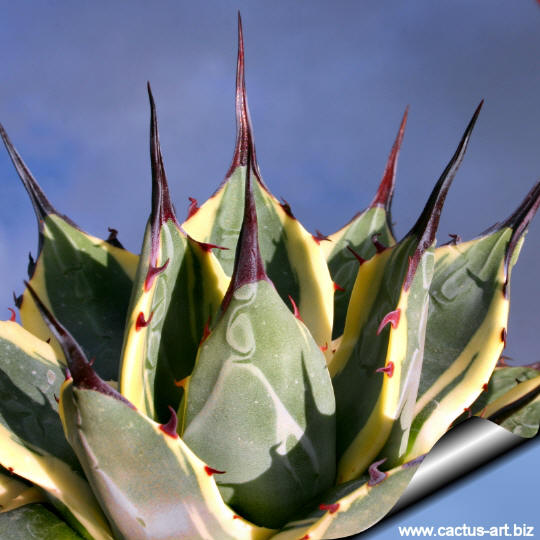|

It look like a giant artichoke with
somewhat wide, short pale blue leaves margined with cream coloured edges
and a dark-red, sharp terminal spine and small, but very sharp reddish
lateral leaf spines.
Description: Agave Patonii "variegata" is the dwarf, small
growing, variegated form of Agave Parryi (but there are
many that don't believe this plant to be a cultivar of Agave
parryi and suggests it may be a cultivar of Agave applanata)
This cultivar is also found under a few different names like:
Agave patoni 'Cream Spike' or 'Dwarf variegated',
or with the Japanese names Agave parry 'Merico Nishiki',
' Ohikitsusyote Nisiki' or 'Toyoushi'.
Other names include: Agave minima 'Variegata', Agave
pattonii marginata or 'alba marginata'
It shoots off pups/offsets readily as the mother plant matures.
Stem: Acaulescent.
Rosettes: Compact, looking like
a giant artichoke, that grows to only 10-12 cm tall by about 15-12 (or
more) cm wide.
Leaves: Essentially smooth light blue-grey-green to olive
green, very broadly oblong, quickly acuminate, openly concave
(spoon-shaped), margined with cream coloured edges and with a stiffly
erect-spreading; spine somewhat flexuous, from purple-chestnut becoming
dull gray-brown. The margins occasionally have a seasonal slight flush
of red at the leaf tip and base. Marginal spines are well spaced.
Flowers: Blooms only when the plant is 20 years old or more. The
flower stalk is up to 3 (or more) meters tall with small orange to
yellow flowers. The plant then dies leaving suckers that grow into
replacement plants.
Cultivation: A very slow
growing Agave patonii variegata is a real beauty and worth
the wait, it is highly ornamental and very beautiful. Like all agaves it
is extremely drought tolerant. Although it will grow larger with
supplemental water, its roots need to be in well-drained soil, and will
rot if kept wet. Likes full sun, but will tolerate shade. One of the
hardiest agaves (Resistant to -7°C or less) In winter watering this
plant can be done once every 1-2 months, there is no need to mist the
leaves.
Propagation: By
suckers: Remove the basal suckers in spring or summer and let
the cuttings dry for a few days before inserting in compost.
Use: They are attractive
massed in the succulent garden, they are also wonderful when used for
accent or simply to provide some all year round foliage colour and often
used in a pot as a patio plant, they make an eye-catching statement and
along with other evergreen plants in pots, can be moved around to change
the scenery or position to give more shelter. It is also well suited for
containers.
Photo of conspecific taxa, varieties, forms and
cultivars of Agave parryi:

 |